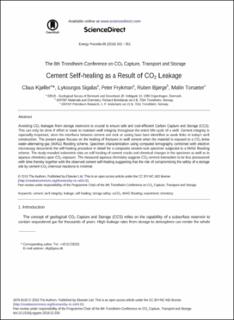| dc.contributor.author | Kjøller, Claus | |
| dc.contributor.author | Lykourgos, Sigalas | |
| dc.contributor.author | Frykman, Peter | |
| dc.contributor.author | Bjørge, Ruben | |
| dc.contributor.author | Torsæter, Malin | |
| dc.date.accessioned | 2020-12-15T14:09:44Z | |
| dc.date.available | 2020-12-15T14:09:44Z | |
| dc.date.created | 2016-05-25T14:13:25Z | |
| dc.date.issued | 2016 | |
| dc.identifier.citation | Energy Procedia. 2016, 86 342-351. | en_US |
| dc.identifier.issn | 1876-6102 | |
| dc.identifier.uri | https://hdl.handle.net/11250/2719640 | |
| dc.description.abstract | Avoiding CO2 leakages from storage reservoirs is crucial to ensure safe and cost-efficient Carbon Capture and Storage (CCS). This can only be done if effort is made to maintain well integrity throughout the entire life-cycle of a well. Cement integrity is especially important, since the interfaces between cement and rock or casing have been identified as weak links in today's well construction. The present paper focuses on the healing of fractures in well cement when the material is exposed to a CO2-brine water-alternating-gas (WAG) flooding scheme. Specimen characterization using computed tomography combined with electron microscopy documents the self-healing procedure in detail for a composite cement-rock specimen subjected to a WAG flooding scheme. The study revealed volumetric data on self-healing of cement cracks and chemical changes in the specimen as well as in aqueous chemistry upon CO2 exposure. The measured aqueous chemistry suggests CO2-cement interaction to be less pronounced with time thereby together with the observed cement self-healing suggesting that the risk of compromising the safety of a storage site by cement-CO2 chemical reactions is minimal. | en_US |
| dc.language.iso | eng | en_US |
| dc.publisher | Elsevier | en_US |
| dc.rights | Attribution-NonCommercial-NoDerivatives 4.0 Internasjonal | * |
| dc.rights.uri | http://creativecommons.org/licenses/by-nc-nd/4.0/deed.no | * |
| dc.subject | chemistry | en_US |
| dc.subject | experiment | en_US |
| dc.subject | WAG flooding | en_US |
| dc.subject | scCO2 | en_US |
| dc.subject | storage safety | en_US |
| dc.subject | self-healing | en_US |
| dc.subject | leakage | en_US |
| dc.subject | well integrity | en_US |
| dc.subject | cement | en_US |
| dc.title | Cement Self-Healing as a Result of CO2 Leakage | en_US |
| dc.type | Peer reviewed | en_US |
| dc.type | Journal article | en_US |
| dc.description.version | publishedVersion | en_US |
| dc.rights.holder | © 2016 The Authors. Published by Elsevier Ltd. This is an open access article under the CC BY-NC-ND license | en_US |
| dc.source.pagenumber | 342-351 | en_US |
| dc.source.volume | 86 | en_US |
| dc.source.journal | Energy Procedia | en_US |
| dc.identifier.doi | 10.1016/j.egypro.2016.01.035 | |
| dc.identifier.cristin | 1357506 | |
| dc.relation.project | Norges forskningsråd: 233893 | en_US |
| dc.relation.project | Norges forskningsråd: 193816 | en_US |
| cristin.unitcode | 7401,80,6,1 | |
| cristin.unitcode | 7571,36,0,0 | |
| cristin.unitname | Materialfysikk, Trh. | |
| cristin.unitname | Boring og brønn | |
| cristin.ispublished | true | |
| cristin.fulltext | original | |
| cristin.qualitycode | 1 | |

